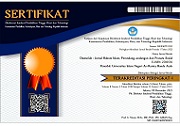CITATIONS
Traditional Mandailing Natal Muslim Women's Clothing: An Analysis of Local Wisdom and the Spirit of Religious Practice According to Islamic Law
Abstract
Abstract
Clothing is a personal right and freedom that integrates social and cultural aspects. This issue demonstrates the complexity and sensitivity of the topic of dressing for Muslim women, which often involves the interaction between personal beliefs, religious law, human rights, and social norms. This research is a type of phenomenological study that will reveal the relationship between traditional clothing of Muslim women in Mandailing Natal and how Islam views it. Data was collected through observation and interviews. The data analysis results show that historically, women in Mandailing Natal have maintained traditional clothing both for customary ceremonies and daily wear. Adaptations and the influence of contemporary trends have also impacted the declining interest among young men and women in preserving their traditional clothing. When weighed against the Islamic legal perspective, which emphasizes modesty, gender appropriateness, simplicity, purity and cleanliness, non-tightness, and the absence of haram elements, the traditional attire of Muslim women in Mandailing Natal is appropriate and should be preserved and maintained.
Keywords: Clothing, Muslim Women, Customs, Islamic Law
Keywords
Clothing, Muslim Women, Customs, Islamic Law
Full Text:
PDFReferences
Al Albani, M. N. (2005). Sahih Abu Dawod. Darussalam.
Al-Baghawi, A. M. al-H. bin M. al-F. (2005). Mukhtashar Tafsir al-Baghawi. Dar al-Ma’rifah.
Al-Bukhari, Abu Abdullah Muhammad bin Ismail, (2011). Ensklopiedia Hadis: Sahih al-Bukhari 1, Terj. Masyar dan Muhammad Suhadi, Jakarta: Almahira, Cet. 1, 2011
Al-Bukhari, Abu Abdullah Muhammad bin Ismail I. (2002). Shahih Al-Bukhari. Dar Ibnu Katsir.
Al-Malibary, Syek Zainuddin Ibn Abd Aziz, (2003), Fath al-Muín, Kairo: Maktabah Daar Al-Turats
Ali, S. (2005). Why Here, Why Now? Young Muslim Women Wearing H ij a b.
Ali, S. S. (2010). Cyberspace as Emerging Muslim Discursive Space? Online Fatawa On Women and Gender Relations and its Impact on Muslim Family Law Norms. International Journal of Law, Policy and the Family, 24(3), 338–360. https://doi.org/10.1093/lawfam/ebq008
Al-Jaza’iri, S. A. B. J. (2003). Minhajul Muslim.
An-Nawawi. (n.d.). Al-Majmu S.
As-Sa’di, S. A. bin N. (2003). Tafsir As-Sa’di.
as-Suyuthi, J. J. (2000). ad-Durr al-Mansur fi at-Tafsir al-Ma’sur. Darul Kutub Ailmiah, Libanon.
Badarneh, M. A., Al-Momani, K., & Migdadi, F. (2016). Between tradition and modernity: The bargaining genre in women’s clothing stores in Jordan. Journal of Pragmatics, 101, 118–137. https://doi.org/10.1016/j.pragma.2016.06.005
Boulanouar, A. W. (2006). The Notion of Modesty in Muslim Women’s Clothing: An Islamic Point of View. In New Zealand Journal of Asian Studies (Vol. 8, Issue 2).
Ciptandi, F., Sachari, A., Haldani, A., & Sunarya, Y. Y. (2018). Identity Shift On Traditional Clothes For Women Tuban, East Java, Indonesia. Proceedings of the 4th Bandung Creative Movement International Conference on Creative Industries 2017 (4th BCM 2017). https://doi.org/10.2991/bcm-17.2018.48
Departemen Agama, R. (2007). Alquran dan terjemahan. In Al-Qur’an Terjemahan.
Droogsma, R. A. (2007). Redefining Hijab: American Muslim Women’s Standpoints on Veiling. Journal of Applied Communication Research, 35(3), 294–319. https://doi.org/10.1080/00909880701434299
Fauzi, A. (2016). Pakaian Wanita Muslimah Dalam Perspektif Hukum Islam. https://doi.org/https://doi.org/10.35897/iqtishodia.v1i1.56
Haris, Dr. Abd. (2018). ETIKA HAMKA ; Konstruksi Etik Berbasis Rasional (P. Islami, Ed.). CV. Mandar Maju. https://books.google.co.id/books?id=jl1nDwAAQBAJ&pg=PA52&dq=arti+etika+kristen&hl=id&sa=X&ved=0ahUKEwj9077njMfnAhUE93MBHZ8nBGAQ6AEIMDAB#v=onepage&q=arti etika kristen&f=false
Hass, B. (2020). The Burka Ban: Islamic Dress, Freedom and Choice in The Netherlands in Light of the 2019 Burka Ban Law. Religions, 11(2), 93. https://doi.org/10.3390/rel11020093
Hirsch, H. (2020). Clothing and Colours in Early Islam. Anthropology of the Middle East, 15(1), 99–114. https://doi.org/10.3167/ame.2020.150108
Idris, & muhaimin, A. (2016). Dakhil al- ‘ Ilmi dalam Kitab al-Jawahir fii Tafsir al- Qur ’ an Karya Tantawii Jawhari. In Al-Thiqah (Vol. 2, Issue 2). http://journal.uin-alauddin.ac.id/index.php/tafsere/article/download/7455/6098
Keciptakaryaan, P. R., & Natal, K. M. (2021). PROFIL KABUPATEN MANDAILING NATAL.
Khalaf, A. W. (2003). Ilmu Ushul Fiqh: Kaidah Hukum Islam. In Jakarta: Pustaka Amani.
Latiff, Z. Abd., & Alam, F. N. S. Z. (2013). The Roles of Media in Influencing Women Wearing Hijab: An Analysis. Journal of Image and Graphics, 1(1), 50–54. https://doi.org/10.12720/joig.1.1.50-54
M. Quraish Shihab. (2005). Tafsir Al-Misbah. In Journal of Materials Processing Technology (Vol. 2, Issue 1). http://dx.doi.org/10.1016/j.cirp.2016.06.001%0Ahttp://dx.doi.org/10.1016/j.powtec.2016.12.055%0Ahttps://doi.org/10.1016/j.ijfatigue.2019.02.006%0Ahttps://doi.org/10.1016/j.matlet.2019.04.024%0Ahttps://doi.org/10.1016/j.matlet.2019.127252%0Ahttp://dx.doi.o
Monto Bauto, L., & Sosiologi FISIP Universitas Haluoleo Kendari, J. (2014). PERSPEKTIF AGAMA DAN KEBUDAYAAN DALAM KEHIDUPAN MASYARAKAT INDONESIA (Suatu Tinjauan Sosiologi Agama). In Jurnal Pendidikan Ilmu Sosial (Vol. 23, Issue 2).
Moustakas, clark. (1994). Phenomenological Research Methods. SAGE Publication, Inc.
Mubit, R. (2016). PERAN AGAMA DALAM MULTIKULTURALISME MASYARAKAT INDONESIA. Epistemé: Jurnal Pengembangan Ilmu Keislaman, 11(1). https://doi.org/10.21274/epis.2016.11.1.163-184
Muhammad Nasib ar-Rifa‟i. (1999). Ringkasan Tafsir Ibnu Katsir Jilid IV.
Pirmasari, D. A. (2021). To veil or not to veil? Islamic dress and control over women’s public appearance. Journal of Gender Studies, 30(2), 136–149. https://doi.org/10.1080/09589236.2020.1863199
Putra, D. (2021). Tradisi Markobar Dalam Pernikahan Adat Mandailing Dalam Perspektif Hukum Islam. El-Ahli : Jurnal Hukum Keluarga Islam, 1(2), 18–34. https://doi.org/10.56874/el-ahli.v1i2.311
Rambocas, M., & Mahabir, J. M. (2021). The effects of consumers’ cultural sensitivity, ethnocentrism and demographical characteristics on attitude toward luxury fashion brands in Trinidad and Tobago. Journal of Fashion Marketing and Management: An International Journal, 25(4), 644–664. https://doi.org/10.1108/JFMM-03-2020-0049
Riyani, I. (2016). THE SILENT DESIRE: ISLAM, WOMEN’S SEXUALITY AND THE POLITICS OF PATRIARCHY IN INDONESIA.
Sabiq, S. (2000). Fikih Sunnah. In Jilid 12. Daar Ar-Risalah.
Sarwar, A., & Zeng, H. (2021). Breaking free from patriarchal appropriation of sacred texts: An Islamic feminist critique of Bol. Asian Journal of Women’s Studies, 27(4), 465–487. https://doi.org/10.1080/12259276.2021.1981526
Siregar, E., Pd, S., & Pd, M. (n.d.). SEJARAH DAN MOTIF BUDAYA MANDAILING NATAL.
Yrd. Doç. Dr. Adem KOÇ*. (2012). THE SIGNIFICANCE AND COMPATIBILITY OF THE TRADITIONAL CLOTHING-FINERY CULTURE OF WOMEN IN KUTAHYA IN TERMS OF SUSTAINABILITY. Millî Folklor, 2012, Yıl 24, Sayı 93, 24(93), 182–189.
Interview
Abdul Waris Nasution, Tokoh Adat Hutabangon, Interviewed by the author, 21 Oct 2023
Dipertuan Ayah H. Monang Pulungan, M.Pd, Traditional Figure/community figure, Interviewed by the author, 20 May 2023
Dipertuan Ayah na lom-lom, Traditional Figure/community figure, Interviewed by the author, 14 Oct 2023
H. Muhammad Nasir Nasution, Religious figures in Mandailing leader of the Indonesian Ulema Council (Majelis Ulama Indonesia or MUI) in the Mandailing Natal Regency. Interviewed by the author, 20 Oct 2023
H. Syamsir Batubara, Religious figures in Mandailing Natal include members of the Fatwa Commission of the Indonesian Ulema Council (Majelis Ulama Indonesia or MUI) in the Mandailing Natal Regency. Interviewed by the author, 20 Oct 2023
Permata Sari Siregar, Interviewed by the author, 16 May 2023.
Yopi Karaman, Interviewed by the author, 16 May 2023.
Zaki Parma Nasution, Interviewed by the author, 16 May 2023.
DOI: http://dx.doi.org/10.22373/dusturiyah.v15i1.26287
Refbacks
- There are currently no refbacks.
Copyright (c) 2025 Dedisyah Putra, Muhadi Khalidi, Raja Ritonga


